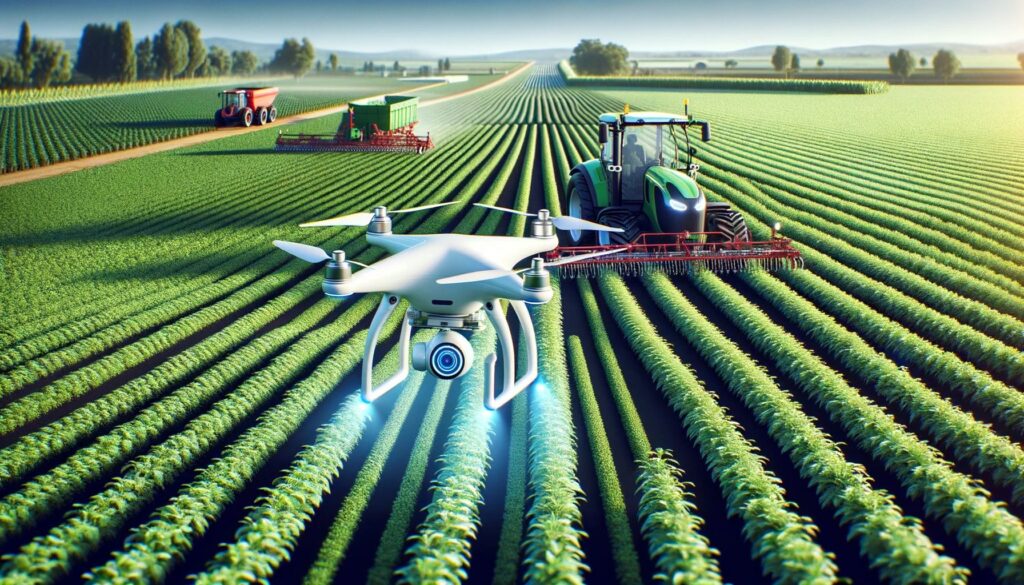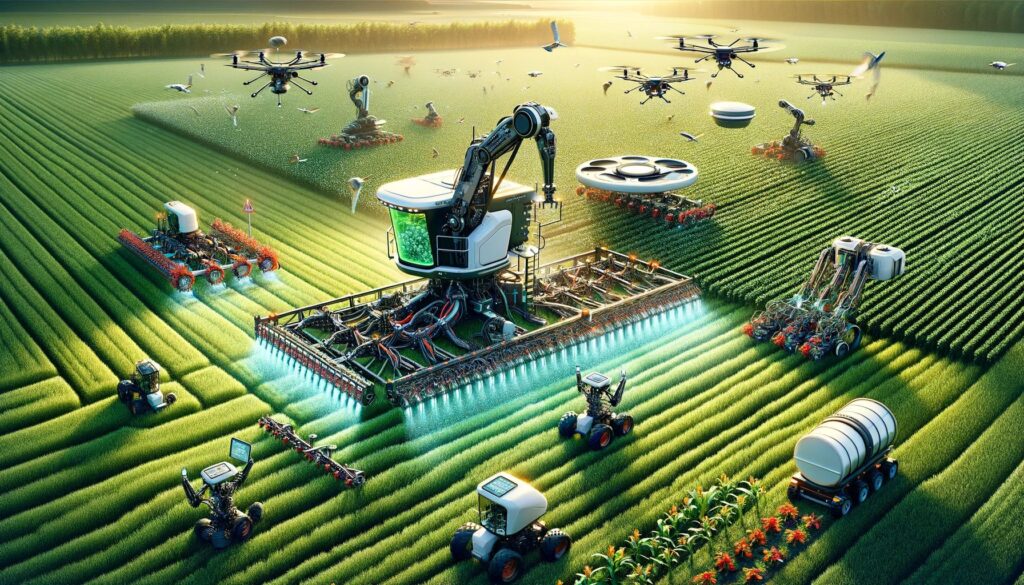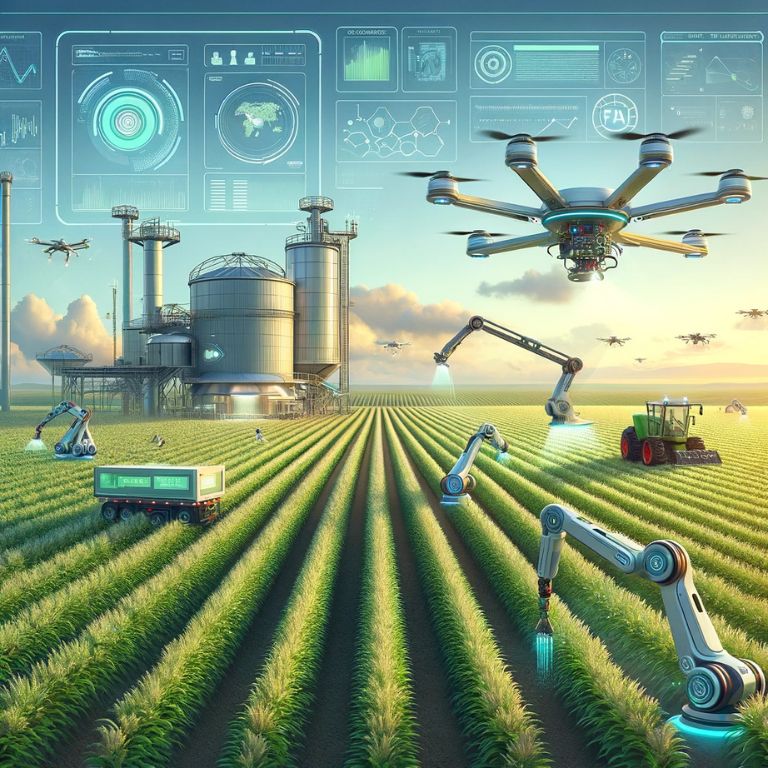Agriculture, one of the oldest and most vital industries, is undergoing a significant transformation, thanks to the advent of Artificial Intelligence (AI). For centuries, farming practices largely depended on manual labor and traditional knowledge. However, the 21st century has witnessed a paradigm shift where technology, particularly AI, is reshaping how we grow food.
The Historical Context
The journey of AI in agriculture began with basic computerization and has evolved into sophisticated AI systems. In the early days, computers assisted in record-keeping and basic data analysis. But the real game-changer was the introduction of machine learning and advanced data analytics. This evolution marked a transition from traditional farming to what we now know as smart farming or precision agriculture.
Current Landscape of AI in Agriculture
Today, AI in agriculture is more than just a buzzword; it’s a reality that’s improving efficiency, yield, and sustainability. Here’s a glimpse of how AI is currently used in agriculture:
- Predictive Analytics: AI algorithms analyze data from various sources like weather forecasts, soil sensors, and satellite imagery to predict weather patterns, pest infestations, and crop yields.
- Precision Farming: This technique uses AI to analyze data from the field (soil conditions, crop health, etc.) to make precise decisions about planting, fertilizing, and harvesting.
- Automated Equipment: Tractors and drones equipped with AI can perform tasks like planting, weeding, and harvesting more efficiently than human labor.
- Crop and Soil Monitoring: AI-powered systems provide real-time monitoring and analysis of crop health and soil conditions, enabling farmers to take immediate corrective actions.
- Resource Management: AI helps in efficient water usage and minimizing the use of fertilizers and pesticides, contributing to sustainable farming practices.
The Statistical Perspective
To put this into perspective, let’s consider some key statistics:
- Increase in Efficiency: AI-driven technologies can increase agricultural productivity by up to 20%.
- Market Growth: The global AI in agriculture market size was valued at $1 billion in 2020 and is projected to reach $4 billion by 2026, growing at a CAGR of 25%.
The Road Ahead
The journey of AI in agriculture is just beginning. With continuous advancements in technology and an increasing focus on sustainable practices, AI is set to play an even more crucial role in the future of farming. This journey, while promising, is not without challenges. Issues such as data privacy, high initial costs, and the need for digital literacy among farmers need addressing for AI to reach its full potential in agriculture.
AI in agriculture represents a confluence of tradition and innovation. It’s a promising frontier that holds the key to not only increased productivity and efficiency but also a sustainable future for global agriculture.
Predictive Analysis in Agriculture
Harnessing Data for Forward-Thinking Farming
Predictive analysis is transforming agriculture into a data-driven field, enabling farmers to make informed decisions based on sophisticated forecasts. This advanced analytics branch leverages historical data, statistical algorithms, and machine learning to predict future agricultural trends.
Understanding Weather Patterns and Crop Cycles
- Weather Forecasting: AI-driven models analyze historical weather data to predict future conditions, crucial for scheduling planting, irrigation, and harvesting. Knowing the likelihood of droughts or heavy rainfall helps farmers optimize water usage and protect crops.
- Crop Yield Predictions: AI models assess soil quality, weather, and historical crop performance to accurately predict crop yields. This allows farmers to effectively plan supply chain and market activities, ensuring better resource management and economic stability.
The Statistical Edge
Predictive analysis in agriculture is backed by compelling statistics:
- Improved Accuracy: AI models have shown up to a 25% improvement in crop yield predictions over traditional methods.
- Risk Reduction: Implementing predictive analytics has reportedly reduced crop failure rates by up to 20% in some areas.
Challenges and Opportunities
Despite its benefits, predictive analysis faces challenges such as the need for high-quality, comprehensive data and the integration of diverse data sources. Adapting models to local conditions also presents a hurdle. However, the opportunities it offers—enhanced food security, optimized resource use, and sustainable farming practices—make it a pivotal technology in modern agriculture.
Predictive analysis is reshaping agriculture. It’s not just about yield improvement; it’s about fostering a resilient, efficient, and sustainable agricultural sector. Embracing this technology equips farmers to anticipate and prepare for future challenges, securing a stable and prosperous agricultural future.
Precision Farming Techniques Enabled by AI

Revolutionizing Agriculture with Tailored Solutions
Precision farming, an approach that uses AI and other technologies, is revolutionizing agriculture by enabling more efficient and effective farming practices. This section delves into how AI-driven precision farming techniques are transforming the agricultural landscape.
AI-Driven Soil Analysis and Crop Management
- Soil Analysis: AI technologies analyze soil data to provide insights into its health, nutrient levels, and moisture content. This information is crucial for determining the most suitable crops to plant, the optimal planting times, and the required fertilizer types and quantities.
- Crop Management: AI systems process data from various sources, including drones and satellites, to monitor crop health. This helps in identifying issues such as nutrient deficiencies or pest infestations early on, allowing for timely interventions.
Enhanced Irrigation and Fertilization Strategies
AI enables smarter irrigation and fertilization strategies:
- Smart Irrigation Systems: These systems use AI to analyze weather forecasts and soil moisture levels to optimize water usage, ensuring crops receive the right amount of water at the right time.
- Targeted Fertilization: AI algorithms recommend precise fertilizer application rates and timings based on the specific needs of each crop, reducing waste and environmental impact.
Integrating AI with Farm Equipment
Modern farm equipment, like tractors and drones, are increasingly AI-enabled:
- AI-Powered Tractors: These tractors can autonomously navigate fields, plant seeds, and apply fertilizers and pesticides accurately.
- Drones in Agriculture: Drones equipped with AI and advanced sensors provide aerial imagery for crop monitoring, enabling farmers to make informed decisions.
The Impact of AI on Precision Farming
To quantify the impact of AI on precision farming, consider these points:
- Increased Crop Yields: AI-driven precision farming can increase crop yields by up to 30% by optimizing various farming practices.
- Resource Efficiency: It also significantly reduces resource use, like water and fertilizers, contributing to sustainable agriculture.
Future Prospects and Challenges
While AI-driven precision farming holds great promise, challenges such as high implementation costs and the need for technical expertise among farmers must be addressed. However, the future looks bright, with ongoing advancements in AI technology promising even more efficient and sustainable farming practices.
AI-driven precision farming techniques are at the forefront of agricultural innovation. They offer a unique blend of efficiency, sustainability, and productivity, paving the way for a smarter, more resource-conscious future in farming.
AI in Crop Health Monitoring
Advancing Agricultural Practices Through Intelligent Monitoring
The application of Artificial Intelligence (AI) in crop health monitoring represents a significant leap forward in agricultural technology. This section explores how AI is being utilized to enhance crop health monitoring, contributing to more efficient and effective farming practices.
Innovative Approaches to Pest Control and Disease Detection
- AI-Powered Pest Detection: AI algorithms, trained on vast datasets of crop images, can identify pest infestations with remarkable accuracy. This early detection allows farmers to take timely and targeted actions to control pests, minimizing crop damage.
- Disease Diagnosis and Prevention: AI systems can detect plant diseases by analyzing symptoms visible on crop leaves. This early diagnosis helps in preventing the spread of diseases and reducing reliance on broad-spectrum pesticides.
Role of Drones and Satellite Imagery in Crop Monitoring
Drones and satellites equipped with AI and high-resolution cameras play a pivotal role in crop monitoring:
- Drones in Detailed Crop Inspection: Drones fly over fields, capturing detailed images that AI systems analyze to assess crop health, identify areas of concern, and even predict future issues.
- Satellite Imagery for Large-Scale Monitoring: Satellite imagery, combined with AI, provides a broader view of crop health across large areas, helping in large-scale agricultural management and decision-making.
Statistical Insights and Real-World Impact
The impact of AI in crop health monitoring is backed by compelling statistics:
- Increased Detection Accuracy: AI systems have shown to improve pest and disease detection accuracy by up to 95%.
- Reduced Crop Losses: Early detection and targeted interventions have led to a reduction in crop losses by as much as 30% in some cases.
Overcoming Challenges and Looking Ahead
While the integration of AI in crop health monitoring offers immense benefits, it is not without challenges. The accuracy of AI systems depends heavily on the quality and quantity of data. Additionally, there is a need for robust infrastructure to support these technologies, especially in remote farming areas.
Nevertheless, the future of crop health monitoring looks promising with AI at the helm. Continued advancements in AI and machine learning, coupled with more accessible technology, are set to further revolutionize this aspect of agriculture.
AI’s role in crop health monitoring is a testament to how technology can be harnessed to make agriculture more efficient, sustainable, and productive. By leveraging AI for early detection and precise interventions, farmers can significantly improve crop health and yields, paving the way for a more food-secure future.
Automation and Robotics in Farming

The AI-Driven Evolution of Agricultural Machinery
The integration of automation and robotics, powered by Artificial Intelligence (AI), is revolutionizing the farming industry. This section delves into how AI is shaping the future of farm machinery and robotics, enhancing efficiency and productivity in agriculture.
AI in Farm Machinery
- Autonomous Tractors: AI-enabled tractors can autonomously plow, sow, and harvest crops with high precision, reducing the need for manual labor and increasing efficiency.
- Smart Harvesting Systems: Robotics equipped with AI algorithms are being used for harvesting fruits and vegetables. These systems can identify ripe produce and harvest them with minimal damage, something that was challenging with traditional machinery.
The Role of Robotics in Planting and Weeding
Robotics in agriculture extend beyond harvesting:
- Precision Planting: Robots can plant seeds at exact depths and spacing, optimizing growth conditions and improving crop yields.
- Automated Weeding: AI-driven robots can identify and remove weeds without harming the crops, reducing the reliance on chemical herbicides.
Impact and Statistical Analysis
The use of AI in farm machinery and robotics is not just a theoretical concept; it’s a practical solution with measurable benefits:
- Labor Efficiency: Automated machines can work around the clock, significantly increasing productivity.
- Yield Improvement: AI-driven systems have been shown to improve crop yields by up to 20%, thanks to precise and efficient farming practices.
Addressing the Challenges
Despite the advantages, the adoption of AI in farm machinery and robotics faces challenges like high costs, the need for technical expertise, and infrastructure development. However, as technology becomes more affordable and accessible, these challenges are gradually being overcome.
Future Prospects
The future of automation and robotics in farming is bright, with ongoing technological advancements promising even more sophisticated and efficient agricultural practices. The integration of AI with robotics is set to usher in a new era of precision agriculture, characterized by sustainability, efficiency, and high productivity.
The integration of AI in farm machinery and robotics is a significant step forward in the evolution of agriculture. It not only enhances efficiency and yield but also opens up new possibilities for sustainable farming practices. As technology continues to advance, the potential for AI-driven automation and robotics in agriculture is boundless, paving the way for a more efficient and sustainable agricultural future.
AI’s Impact on Sustainable Farming Practices
Pioneering a Greener Future in Agriculture
In the era of environmental consciousness, Artificial Intelligence (AI) plays a pivotal role in driving sustainable farming practices. This section explores how AI is contributing to the sustainability of agriculture, addressing key challenges like water conservation and efficient resource management.
AI in Water Conservation and Resource Management
- Smart Irrigation Systems: AI-driven irrigation systems optimize water usage by analyzing data from soil moisture sensors, weather forecasts, and crop types. These systems ensure that crops receive the right amount of water at the right time, significantly reducing water wastage.
- Efficient Use of Inputs: AI algorithms help in applying the precise amount of fertilizers and pesticides needed, minimizing environmental impact and preserving soil health.
The Role of AI in Organic Farming
AI is also making significant contributions to organic farming:
- Natural Pest Control: AI systems can predict pest outbreaks and suggest natural control methods, reducing the reliance on chemical pesticides.
- Soil Health Monitoring: AI tools assess soil health, providing insights into organic matter levels and microbiome balance, crucial for organic farming.
Statistical Insights into Sustainable Practices
The impact of AI on sustainable farming is quantifiable:
- Water Usage Reduction: AI-driven irrigation systems have been shown to reduce water usage by up to 20% in some cases.
- Decrease in Chemical Usage: Precision application of inputs can lead to a reduction in fertilizer and pesticide use by up to 15%.
Overcoming Sustainability Challenges
While AI offers tremendous benefits in promoting sustainable farming, challenges such as the integration of AI tools with existing farming practices and the initial investment costs need addressing. There is also a need for farmer education and training in AI technologies.
Future Trends and Opportunities
The future of sustainable farming with AI is promising. As AI technology continues to evolve, we can expect more innovative solutions that further reduce the environmental footprint of agriculture while maintaining high productivity.
AI’s role in promoting sustainable farming practices is a major step towards a greener and more sustainable agricultural sector. By leveraging AI for water conservation, efficient resource use, and support of organic farming, the agricultural industry is not only enhancing productivity but also contributing to environmental conservation and the well-being of future generations.
Future of Agriculture with AI
Embracing Next-Generation Farming Technologies
The agricultural sector stands on the brink of a technological revolution, with Artificial Intelligence (AI) playing a crucial role in shaping its future. This section explores the emerging trends, potential developments, and the challenges and opportunities that lie ahead in AI-driven agriculture.
Emerging Trends in AI-Driven Agriculture
- Advanced Predictive Analytics: Future AI systems will offer even more precise predictions for weather, soil conditions, and market trends, aiding in risk management and decision making.
- Enhanced Crop Genetics: AI will play a key role in genetic engineering, helping to develop crop varieties that are more resistant to pests, diseases, and extreme weather conditions.
- Personalized Farming Solutions: AI will enable more personalized approaches to farming, considering individual farm characteristics to provide tailored recommendations.
Potential Developments in AI and Agriculture
Looking ahead, several exciting developments are on the horizon:
- AI-Integrated Supply Chain Management: AI will further streamline agricultural supply chains, enhancing efficiency from farm to table.
- Robotics and Autonomous Equipment: The next generation of farm robots and autonomous vehicles will be more sophisticated, capable of performing complex tasks with minimal human intervention.
Challenges and Opportunities
The future of AI in agriculture is not without challenges:
- Technological Adoption: The widespread adoption of AI in agriculture is dependent on overcoming barriers such as high costs and the need for technological infrastructure.
- Data Privacy and Security: As agriculture becomes more data-driven, issues related to data privacy and security will become increasingly important.
Despite these challenges, the opportunities are immense. AI has the potential to transform agriculture into a more efficient, sustainable, and productive industry.
The Road Ahead: Balancing Technology and Tradition
The integration of AI in agriculture is not just about adopting new technologies; it’s about balancing innovation with traditional farming practices. It involves respecting and understanding the nuances of agriculture while leveraging technology to enhance its potential.
The future of agriculture with AI is bright and full of possibilities. As we continue to advance technologically, AI will play an increasingly vital role in shaping a sustainable, efficient, and productive agricultural sector, capable of meeting the growing global food demand while preserving the environment.
AI’s Transformative Impact in Agriculture
AI in agriculture is revolutionizing farming with enhanced efficiency, sustainability, and productivity. It’s transforming practices through predictive analysis, precision farming, crop monitoring, and robotics, leading to better yields, resource management, and eco-friendly methods. As AI tackles challenges like resource wastage and climate change, its future role in agriculture is set to expand. Overcoming hurdles in tech adoption, data privacy, and infrastructure is key. Balancing innovation with traditional practices, AI promises a more sustainable, efficient, and food-secure future, offering endless possibilities for global food systems.




